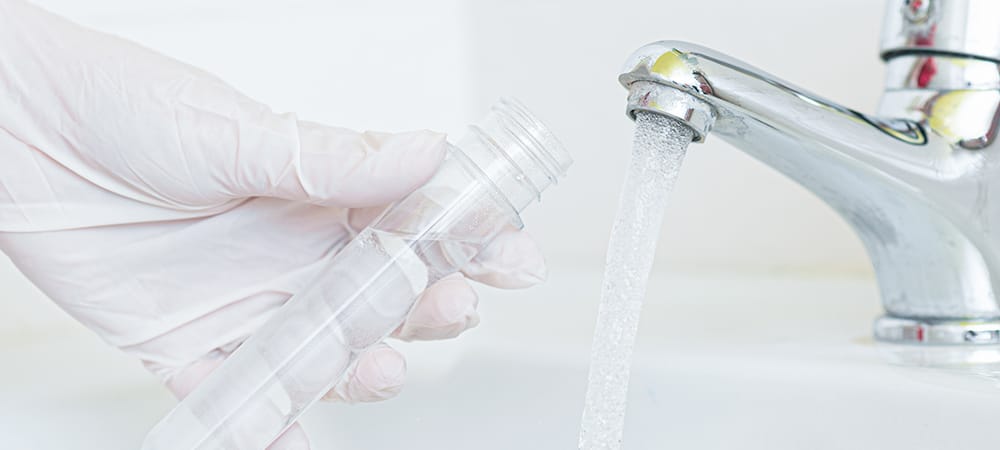
Drinking water: New frameworks needed to account for multiple contaminants and protect public health
November 2021
To make sure all communities have better and safer drinking water, EWG research strives to push federal agencies to increase public health protections and invest in drinking water infrastructure.
Our recent work shows how important it is to update federal legal limits that make public health the priority.
Drinking water in communities across the U.S. contains mixtures of contaminants – including arsenic, radioactive elements, disinfection byproducts and nitrate, among others – and our most recent research shows how badly we need new frameworks that can measure exposure to multiple contaminants at one time.
EWG’s drinking water standards are informed by science-backed health advisories, current water quality data and our most recent peer-reviewed research. They do not include the outdated compromises built into current federal legal limits.
EWG’s Tap Water Database, a publicly accessible one-of-a-kind landmark resource, brings together a vast amount of information – more than 32 million water quality test results from more than 50,000 community water systems in all 50 states – to show how many regulated and unregulated contaminants are present in a water system, and whether those pollutants exceed science-based guidelines to protect public health.
More broadly, the database, which is currently being updated for release in fall 2021, helps communicate to the public about the potential health risks of contaminants in their drinking water. It also highlights key gaps in water research.
Assessing the cumulative impact of contaminant mixtures in drinking water
Federal drinking water standards focus on regulating one chemical at a time, a process too slow to keep pace with science or the rate at which new contaminants are found in drinking water. These legal limits also allow higher concentrations of contaminants than what many scientists consider safe.
In a recent case study using California data, EWG’s novel approach – the first to apply this framework to drinking water contaminants – found more than 20 carcinogens at levels that could put the public at risk, even when the tap water met federal drinking water standards.
For instance, an excess of 15,000 lifetime cancer cases across California could be attributed to drinking water, according to the study, which was published in the journal Environmental Health, in 2019. Assessing the cumulative health risk of multiple contaminants and identifying technologies to remove them together is a more efficient way to guide investments that protect water quality than analyzing them one by one.
Because of the contaminants in their water, communities served by smaller water systems tend to have a greater cancer risk, according to our analysis. Investment in solutions to improve water quality must be adaptable to smaller systems.
Building on our work on California, our national analysis later in 2019 estimated that exposure to carcinogens in tap water could cause more than 100,000 additional U.S. cancer cases. EWG’s approach accounted for the health risk of 22 carcinogenic contaminants commonly found in drinking water.
As with the California case study, this cancer risk is mostly due to arsenic, disinfection byproducts and the radioactive elements uranium and radium. Systems most at risk from contamination with arsenic and radioactive elements tend to serve smaller communities that rely on groundwater.
Our research revealed that disinfection byproducts, found in the drinking water of most of the U.S. population, are a significant cause of cancer risk. Disinfectants like chlorine are necessary to prevent water-borne microbial diseases, but the disinfectants form toxic byproducts once they react with the sediments and dead plant material in the source water.
Developing new health-based water standards for carcinogenic contaminants
In 2020, EWG’s new tests of an expanded list of disinfection byproducts – including a certain class of unregulated haloacetic acids – showed the potential threat to public health caused by exposure to these contaminants.
The findings also highlighted flaws in the way drinking water health guidelines are set and examined approaches to developing limits that protect the public. The analysis measures cancer risks from exposure to disinfection byproducts, providing data that can be used in the development of new standards for disinfection byproducts in drinking water.
For the study, published in the International Journal of Environmental Research and Public Health, we looked at common ways to set drinking water guidelines. The most protective approach would include evidence from human studies, which capture real world exposures to both regulated and unregulated water contaminants.
Another EWG study analyzed nitrate, another common contaminant. The Environmental Protection Agency’s limit for nitrate is based on health recommendations more than 30 years old, set to prevent blue baby syndrome, which can occur when excessive nitrate ingestion leads to a lack of oxygen in the infant’s blood.
But newer data shows that nitrate exposure in water can also elevate cancer risks, EWG found in a 2019 analysis. Nitrate pollution of U.S. drinking water may cause up to 12,594 excess cases of cancer a year, and cost up to $1.5 billion for health care. Nitrate contamination of drinking water may also be responsible each year for 2,939 babies born at very low weight or 1,725 babies born very preterm.
EWG scientists defined a new nitrate water guideline to protect against those cancer risks while also protecting against harm to the developing fetus. EWG’s recommendation is almost 100 times stricter than the current EPA legal limit for nitrate.
What’s next? Federal standards that protect drinking water in all communities
It’s clear that many EPA drinking water standards do not fully protect our health. Drinking water that clears the EPA’s low bar is not necessarily free either from health risks or the dangers posed by cumulative exposure to contaminants.
EWG will continue to pursue groundbreaking research to fill the gaps in drinking water quality data as we push for better tap water quality in all communities.
###
